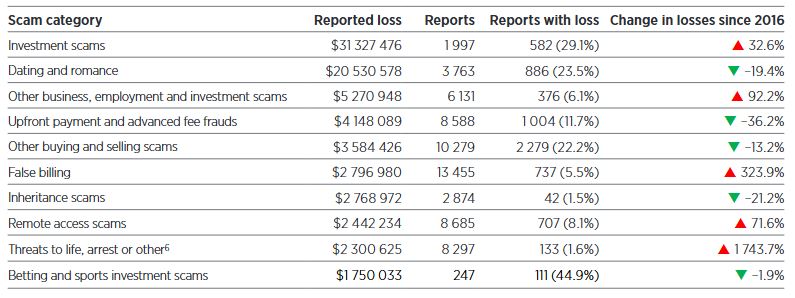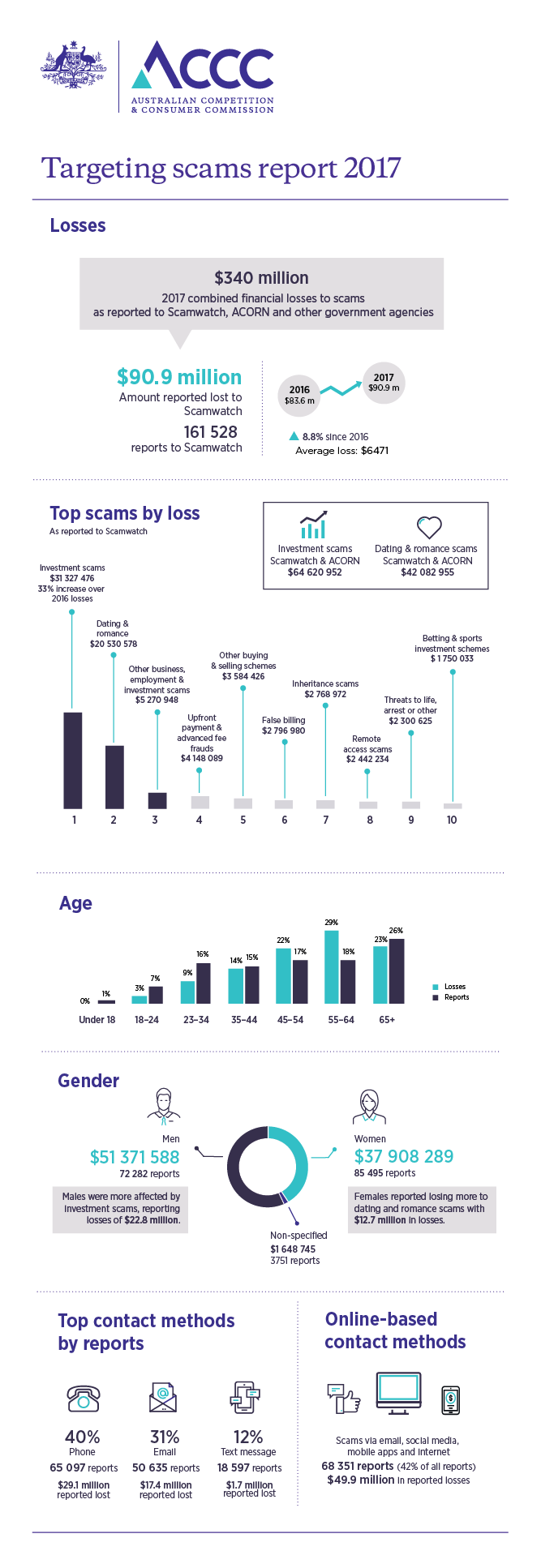The ACCC says that Australians lost more money to scammers in 2017 than in any other year since the ACCC began reporting on scam activity. According to the ACCC’s ninth annual Targeting scams report more than 200,000 scam reports were submitted to the ACCC, Australian Cybercrime Online Reporting Network (ACORN) and other federal and state-based government agencies in 2017. Total losses reported were $340 million – a $40 million increase compared to 2016.
 The top three most reported scam categories of 2017 were phishing, identity theft and false billing scams. Losses to investment scams reported to Scamwatch increased by 33 per cent which translates to an increase in losses of $7.6 million. Combined losses with ACORN reports brings investment scam losses to $64.6 million in 2017, an increase over the $59 million in combined losses reported in 2016. False billing scams reported to Scamwatch increased by 324 per cent, from $659 835 in 2016 to
The top three most reported scam categories of 2017 were phishing, identity theft and false billing scams. Losses to investment scams reported to Scamwatch increased by 33 per cent which translates to an increase in losses of $7.6 million. Combined losses with ACORN reports brings investment scam losses to $64.6 million in 2017, an increase over the $59 million in combined losses reported in 2016. False billing scams reported to Scamwatch increased by 324 per cent, from $659 835 in 2016 to
This is the first time reported losses to scams have totalled more than $300 million and demonstrates the increasing impact of scams on Australians. Investment scams topped the losses at $64 million, an increase of more than 8 per cent. Dating and romance scams caused the second greatest losses at $42 million.
“It’s very worrying that Australians are losing such extraordinary amounts to scammers. Based on just the reports provided to the ACCC, victims are losing an average of $6500. In some cases people have lost more than $1 million,” ACCC Deputy Chair Delia Rickard said.
“Some scams are becoming very sophisticated and hard to spot. Scammers use modern technology like social media to contact and deceive their victims. In the past few years, reports indicate scammers are using aggressive techniques both over the phone and online.”
Today marks the beginning of Scams Awareness Week 2018 and this year Scamwatch is asking people to “Stop and check: is this for real?” when they’re contacted by scammers who are pretending to be from well-known government organisations or businesses.
Scamwatch received almost 33,000 reports of these threat-based impersonation scams in 2017. Over $4.7 million was reported lost and more than 2800 people gave their personal information to these scammers.
“These scams can be very frightening. For example, scammers will impersonate the Australian Taxation Office and threaten people with immediate arrest unless they pay an outstanding tax bill. They may pretend to be from Telstra to try to hack into your computer or from Centrelink promising extra payments in return for a ‘fee’,” Ms Rickard said.
“Scammers scare us or butter us up with promises of cash because they know it clouds our judgement. People get so worried about being arrested they don’t question if the person threatening them is genuine.”
“If you’re being threatened, take a deep breath, and ask yourself if the call makes sense. The ATO will never threaten you with immediate arrest; Telstra will never need to access your computer to ‘fix’ a problem; and Centrelink will never require a fee to pay money it owes you. Finally, none of these organisations will ask you to pay using iTunes gift cards,” Ms Rickard said.
“If something doesn’t feel right, hang up the phone or hit delete. If the person said they were, for example, from Telstra or the ATO, find the phone number for that organisation online or in the phone book, call them and let them know about the call you received. They’ll let you know if it’s genuine or a scam.”
The ACCC encourages people to visit www.scamwatch.gov.au (link is external) to report scams so we can warn others about them and learn more about what to do if they’re targeted by scams.

